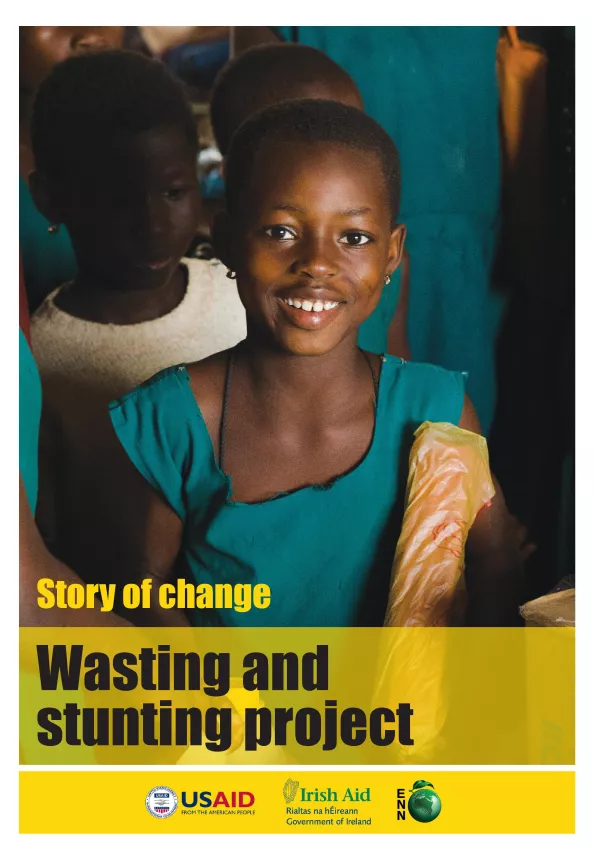Story of change: Wasting and stunting project
Publication details
This report was written by Linda Shaker Berbari, a Technical Associate of the Emergency Nutrition Network (ENN). The report was guided and reviewed by Tanya Khara and Carmel Dolan (ENN Technical Directors and Co-coordinators of the WaSt TIG).
Thanks and appreciation go to the key informants who contributed their insights and their time to participate in the interviews.
This report was made possible by funding from Irish Aid (grant number HQPU/2019/ENN). The ideas, opinions and comments therein are entirely the responsibility of its author(s) and do not necessarily represent or reflect Irish Aid policy.
This report was made possible by the generous support of the American people through the United States Agency for International Development (USAID). The contents are the responsibility of ENN and do not necessarily reflect the views of USAID or the United States Government.
Executive summary
The Wasting and Stunting (WaSt) project was initiated by Emergency Nutrition Network (ENN) in 2014 through the establishment of the WaSt Technical Interest Group (TIG). The project has since been through three phases and is entering its fourth phase. It has accomplished multiple outputs linked to understanding the links between wasting and stunting. As part of its commitment to the evaluation of its work, ENN has documented the implementation of the WaSt project using a Story of Change (SoC) methodology to examine the influence the project has had on policy, programmes and research. Information was collected via semi-structured interviews with identified key informants. Twenty-five people were interviewed and asked to provide their views on the process, successes, challenges and lessons learned, as well as recommendations for the next phase of the project.
The WaSt TIG includes a mix of expert individual members, facilitated by ENN and functioning in an engaging, exploratory and task-oriented manner. The varied composition of the TIG, the participatory approach and flexibility in levels of engagement, aswell as the action and delivery-oriented approach, are viewed as both appropriate and effective. The TIG could benefit from the engagement of members drawn from regional and governmental research entities and through clarifying member roles and responsibilities. ENN is perceived as an excellent facilitator, providing momentum for effectively and efficiently moving the work forward. ENN’s neutrality and independence enables the work to be trusted and, as ENN has the necessary know-how and expertise to guide the work, its wider uptake is further enabled.
In terms of achievements, the main themes that emerged are that the project has:
- Contributed to a solid evidence base around the linkages between wasting and stunting.
- Contributed to a shift in research priorities.
- Contributed to an increase in awareness in the nutrition field around the linkages between wasting and stunting.
- Promoted discussions and a shift in the narrative around wasting and stunting and what is needed to address them at the global level among different institutions, including donor agencies, United Nations (UN) agencies, non-governmental organisations and research institutions.
- Contributed to bridging the divide between the wasting and stunting communities (emergency and development), although this shift may be seen more on the emergency side than on the development side.
- Influenced some institutional policies, although it has only minimally influenced the programmatic level, which is linked to the stage the project is at.
Recommendations for the next phase include:
- ENN to move to the next phase, including to secure funding and keep the momentum going.
- Further disseminate the findings via clear communication packages and increase influencing efforts.
- Increase the focus on disseminating the various outputs to a wider audience in order to increase the project’s influence.
- Increase efforts to translate the evidence into practice, including the implementation of the WaSt study and other similar research studies in order to provide clearer directions around the programmatic implications, as well as clearer guidance for policy change.
- Expand the TIG to include membership from other settings, including those at country and regional levels.
- Engage further with the organisations represented on the TIG and who work directly with governments to increase the uptake of the project’s findings, including UN agencies. Tighten up the process for agreeing and articulating the research questions.
